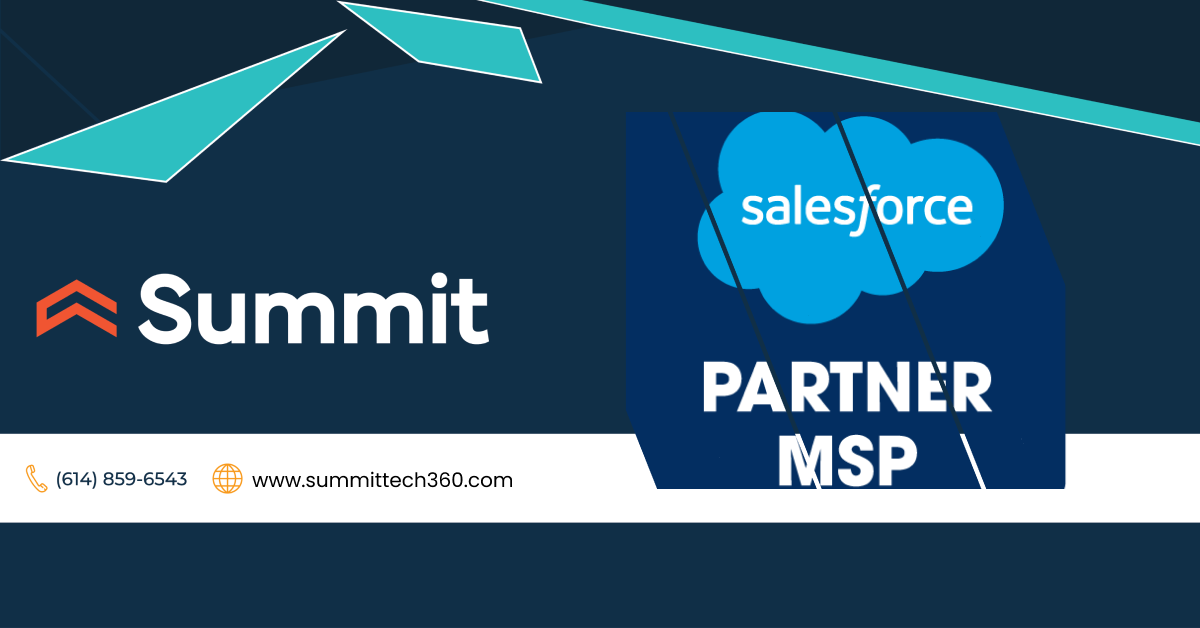Planning a Salesforce implementation? Don’t let avoidable mistakes slow you down. Here are the 10 most common missteps—and the strategies to ensure your solution delivers ROI and long-term success.
Introduction: Why Salesforce Implementations Succeed…or Stall
You can spend months planning a Salesforce rollout, hire Salesforce experts, and still end up with a CRM system no one wants to use. Too many CRM projects launch with fanfare, only to flop in practice.
The problem isn’t Salesforce. It’s the hidden mistakes in planning, execution, and adoption that quietly derail success. Small missteps during the implementation process can snowball into expensive problems, eroding ROI and trust.
The truth? Winning isn’t just about deploying the Salesforce platform; it’s also about the implementation strategy, decisions, and execution behind it.
At Summit, we’ve helped many organizations avoid Salesforce implementation pitfalls to achieve a smooth and successful deployment. Along the way, we’ve seen exactly what separates stalled projects from lasting success.
In this guide, you’ll learn the 10 most common Salesforce implementation mistakes with practical tips and recommendations for avoiding them.
Mistake #1: Not Vetting Salesforce Implementation Partner Fit & Experience
A Salesforce implementation isn’t just a software rollout; it has the potential to transform your business. The partner you choose will shape your system’s design, user adoption, and ROI for years. It’s critical to choose well.
A collaborative approach with your Salesforce implementation partner is essential to ensure a strategic and well-coordinated process that maximizes the Salesforce platform's benefits.
The Risk
Picking a Salesforce implementation partner without proven experience in your use cases or industry leads to:
- Misaligned design that doesn’t reflect your real processes
- Costly rework when requirements weren’t understood the first time
- Low adoption from thin training or weak change management
- Delays and budget creep that drain momentum and trust
How to Avoid This Mistake
- Define “fit” up front. List must-have partner qualifications: industry/domain expertise, integration experience, data migration history, and change management capabilities.
- Ask for Salesforce implementation “rescue” stories. Salesforce Partners who have fixed failed implementations can demonstrate how they diagnose and solve problems effectively.
- Require a clear delivery plan. Look for structured discovery, design documentation, testing plans, and training for users.
- Verify with references. Speak to similar Salesforce clients and ask what challenges they faced and how they overcame them.
Real-World Example: Top Lock Locksmiths experienced this firsthand. Their first Salesforce rollout failed to deliver the field service tools and reporting they needed, leaving teams frustrated. When they partnered with Summit’s Salesforce consulting team, the difference was immediate. Summit reimplemented Salesforce Field Service with automated scheduling, tailored workflows, and targeted training to ensure adoption from day one.
The outcome? A failed rollout became a fully adopted Salesforce solution that continues to drive efficiency and growth. As Matt Hornik, COO, shared:
“We love the Summit Team – they are true professionals and have acted with confidence to deliver a superior implementation of Field Service. We look forward to our continued work with their team as we embark on our Salesforce Journey.”
👉 View the Top Lock Locksmiths Salesforce case study.

Mistake #2: Rushing or Skipping Requirements Planning
A successful Salesforce implementation isn’t just about turning on software; it’s about building a system that works the way you work. Skip or speed through the planning phase, and you’re essentially guessing at the blueprint for your business engine.
The Risk
When organizations skip or speed through requirements planning, they often end up with:
- Generic, “one-size-fits-all” CRM platforms that ignore business nuances
- Costly rework to retrofit the CRM system after launch
- Low adoption because it doesn’t match how users work
- Missed automation opportunities that could have saved hours every week
Without a clear, detailed understanding of how your business operates and a detailed plan for your Salesforce implementation, even the most advanced Salesforce solution will underdeliver.
How to Avoid This Mistake
- Commit to discovery. Give it the time it deserves, even if it feels slow.
- Document everything. Capture every process, pain point, and dependency before system design starts.
- Pick partners who listen. They should be able to restate your needs in detail before proposing solutions.
- View discovery as an investment. The upfront effort pays off in efficiency, adoption, and ROI for years to come.
This step is so critical to the way we approach solutions at Summit. When addressing complex needs, we prioritize thorough discovery and detailed documentation. We work closely with you to map workflows, pain points, and integrations required before any build begins. This ensures a Salesforce system tailored exactly to how your business operates, avoiding generic solutions, costly rework, and low adoption. Investing time upfront to capture every detail pays off in a smoother, more efficient implementation and long-term success.
Real-World Example: The St. Louis Development Corporation (SLDC) needed a way to manage its Economic Justice Action Plan, a large-scale initiative designed to deliver equitable and inclusive economic development across the city. What started as a spreadsheet quickly became unmanageable due to the complexity of tracking pillars, strategies, objectives, and projects.
Summit’s Salesforce consulting team helped SLDC bring the plan into Salesforce Sales Cloud, implementing both standard and custom objects, dashboards, and a developer portal to streamline applications and reporting. The project eliminated manual data entry, improved efficiency, and gave SLDC greater visibility into projects and compliance across the organization. As SLDC explained:
“This required a bit of customization and a lot of Summit listening, digesting, and understanding of our organization and what we’re seeking (even when we weren’t exactly sure what it was that we needed). They made the effort to understand us and to advise us which has helped us create a very successful product to date… They’re a great partner.”
👉 Read the full Salesforce case study with SLDC.
Mistake #3: Not Defining Business Objectives & Success Metrics
A Salesforce implementation can check every technical box and still miss the mark if it’s not built to achieve clear, measurable business goals. Without them, you risk ending up with a CRM system that looks impressive on paper but fails to solve your most urgent challenges.
PMI research shows 37% of projects fail due to a lack of defined objectives and milestones.
The Risk
When a project launches without agreed-upon objectives and measurable KPIs, the result is often:
- Unclear ROI – No baseline or target makes it impossible to measure the system’s value.
- Feature Creep – Without focus, scope expands with “nice-to-have” features that don’t serve the core mission.
- Low User Adoption – If users can’t see how the new system supports their work, they won’t fully engage.
- Missed Strategic Wins – Minor process improvements happen, but the big problems remain unsolved.
How to Avoid This Mistake
- Define outcomes first. Decide exactly what success looks like before touching the tech.
- Tie features to goals. Every item in scope should link to a business objective.
- Set measurable targets. Without numbers, you can’t track progress or prove ROI. Use KPIs such as user adoption, sales performance (new opportunities, closed deals), and customer satisfaction to measure overall success.
- Use metrics to steer the project. Let them guide design decisions and post-launch optimizations.
When your CRM platform is built with your objectives at the center, every dollar you invest moves you toward strategic wins you can measure and celebrate. To maximize project success, ensure alignment between your business goals and the technical implementation throughout the process.
Real-World Example: The Utah Department of Corrections (UDC) had a recruiting process that was manual, time-consuming, and difficult to manage. They needed a seamless connection between NEOGOV and a public-facing portal, plus a way to keep candidates engaged through segmented marketing. Summit’s Salesforce consulting team designed a solution built around those specific objectives.
The results were transformative: UDC went from year-over-year recruiting losses to surpassing all annual hiring targets and catching up on the prior year’s shortfall. Recruiting timelines dropped from 90+ days to just 45, efficiency improved by 70%, and manual reporting was reduced by 30 hours each month.
👉 Read the full Utah Department of Corrections Salesforce case study.

Mistake #4: Weak Project Sponsorship & Stakeholder Engagement
A Salesforce implementation isn’t just a technology project; it’s an organizational change initiative. Without strong executive sponsorship and active stakeholder involvement, even the best technical build can fall flat. The right leadership keeps priorities clear, decision-making swift, and momentum strong. Without it, projects stall, drift, or face pushback from the very people meant to benefit.
Managing and aligning stakeholder expectations throughout the Salesforce implementation process is essential to ensure everyone is working toward the same goals and desired outcomes.
The Risk
When leadership isn’t actively championing the project or key stakeholders aren’t meaningfully involved, CRM initiatives often face:
- Lack of Clear Direction – Without a central advocate, the project can drift, with decisions delayed and goals diluted.
- Resistance to Change – Users who feel excluded from the process are less likely to embrace the system.
- Missed Requirements – Important needs go unrecognized when the right voices aren’t in the room.
- Fragmented Solutions – Teams may build isolated fixes rather than a unified, organization-wide system.
How to Avoid This Mistake
- Appoint a clear executive sponsor with authority to make decisions.
- Include cross-department voices early to capture the full picture.
- Keep communication flowing between the project team and stakeholders.
- Use engagement sessions for alignment, not just a feature wish list.
- Focus on aligning stakeholder expectations early in the project to ensure all parties are clear on responsibilities and desired outcomes.
When sponsorship is strong and stakeholders feel heard from the start, CRM projects transform into collaborative wins that serve the entire organization.
Mistake #5: Over-Customizing or Under-Configuring
Salesforce is an incredibly powerful platform right out of the box, but it’s also flexible enough to be molded to almost any business process. That flexibility is both a superpower and a trap.
Push customization too far, and you’ll end up with a system so complex it’s expensive to maintain, hard to upgrade, and nearly impossible to adapt when your business changes. Under-configure it, and you’ll leave time-saving automation, better reporting, and efficiency gains sitting unused.
The goal? Balance—using native Salesforce features wherever possible and customizing only where it truly delivers unique, business-critical value.
The Risk
When organizations fall into either extreme, they face:
- Over-Customization – Higher development costs, difficult upgrades, long-term technical debt, and a rigid system that is hard to adapt.
- Under-Configuration – Untapped automation, weaker reporting, and missed opportunities to streamline workflows.
- Reduced ROI – The system doesn’t fully deliver on its promise, either because it’s burdened by complexity or limited by neglect.
The key to avoiding this mistake is balance: leverage Salesforce’s native features wherever possible and reserve customization for areas where it truly delivers unique, business-critical value.
How to Avoid This Mistake
- Start with what Salesforce already offers—native functionality is built to last and evolve.
- Customize with intent—only where there’s a clear, measurable business case.
- Use custom fields judiciously—tailor Salesforce to your business needs by adding custom fields only when necessary, avoiding unnecessary complexity.
- Think ahead—ensure custom work won’t limit upgrades or future scalability.
- Use Salesforce ecosystem tools—AppExchange, Communities, and Salesforce-native features can fill gaps without reinventing the wheel.
Balanced implementations aren’t just easier to maintain; they deliver better adoption, stronger ROI, and the agility to evolve with your business.
Real-World Example: The Ohio State University College of Dentistry’s Sterilization Monitoring Service (OSU SMS) needed to replace a legacy Microsoft Access system that couldn’t scale or securely share test results with clients. A prior attempt at a web-based solution had already failed. Summit’s Salesforce consulting team rebuilt the application in Sales Cloud, combining standard features with targeted customization, such as a Lightning component to process up to 1,500 daily tests and a secure Salesforce Experience Cloud customer portal for clients to access real-time results and compliance reports.
The result was a scalable Salesforce solution that streamlined operations, reduced manual effort, and improved transparency. Clients now benefit from secure self-service access to test results and compliance reports, while OSU SMS gained the ability to grow its program efficiently without adding staff.
👉 Read the full Ohio State University Salesforce case study.
Mistake #6: Neglecting Data Migration & Integration Complexity
One of the fastest ways to derail a CRM project is to underestimate the complexity of data migration and system integrations. Data is the lifeblood of your CRM platform, and if the migration or integrations go wrong, everything else suffers.
Accurately migrating CRM data, including customer details, sales records, and support tickets, is essential to maintain business continuity and ensure the new system performs as expected.
On the surface, it can seem straightforward: just move the data from the old system to the new one, connect it to your existing tools, and you’re done. Right?
In reality? This stage can be a minefield. If it’s not handled with precision, you risk damaging trust in the system before it even launches.
The Risks
When data migration and system integration are treated as an afterthought, the fallout can be costly:
- Data Loss or Corruption – Missing, inaccurate, or mismatched records can erode user trust and compromise decision-making.
- Broken Workflows – Without seamless connections to ERP, marketing automation, or service platforms, business processes can grind to a halt.
- Delays & Cost Overruns – Mapping, cleansing, and reconciling data often take longer than expected, especially if issues are only caught late in the project.
- Low User Adoption – If people can’t trust the data or have to enter it twice, enthusiasm drops fast.
The Bottom Line: Without clean, complete, and connected information, even the most beautifully designed Salesforce build can fall flat. Effective data management is crucial for ensuring data integrity, optimizing system efficiency, and supporting ongoing operations.
It’s key to make data planning a top priority from day one, auditing, cleansing, mapping, and defining integration requirements before a single record is moved. Data modeling should also be considered as a key step in preparing for complex integrations and future scalability.
How to Avoid This Mistake
- Start with a Data Audit – Identify what’s clean, what needs work, and what can be archived before migration begins.
- Map Before You Move – Define exactly how each data field and object will translate into Salesforce.
- Clean Early, Not Late – Resolve duplicates, incomplete records, and inconsistencies before migration day.
- Plan for Integrations from Day One – Include ERP, marketing, and service tools in your requirements, not as an afterthought.
- Test, Test, Test – Run mock migrations and integration tests to catch issues before go-live.
When you treat data migration and integration as strategic, not technical, you build a CRM foundation that people trust and use, from day one.
Real-World Example: University of Cincinnati Online (UC Online) had just three months to migrate millions of records from HubSpot to Salesforce before their HubSpot licenses expired. The project required accurate migration of massive data volumes, recreation of hundreds of email templates and journeys, and training 30+ recruiters to ensure effective use of Salesforce and Marketing Cloud.
Summit’s Salesforce consulting team used Tibco Scribe, custom data extraction scripts, and Salesforce Data Loader to execute a precise migration, while also designing a customized training program to prepare recruiting, retention, and marketing teams.
The project was completed on time and without major obstacles. Administrators are now empowered to support users and extend the solution, while recruiters report improved usability, functionality, and overall experience compared to the old system.
👉 Read the full University of Cincinnati Online Salesforce case study.
CRM success depends on data you can trust and systems that work together. When migration and integration are approached with the same rigor as the rest of the project, the result isn’t just a smooth go-live, it’s a foundation for lasting value.

Mistake #7: Overlooking Security, Compliance & Permissions
In regulated industries, one overlooked security setting can cost millions of dollars and undo years of trust.
Security can’t be an afterthought. It must be designed into the CRM from day one, because bolting it on later is costly, risky, and often too late.
Neglecting security, compliance, and permissions puts you at serious risk for:
- Compliance Violations – Failing to meet privacy laws and regulations such as HIPAA, GDPR, SOX, FERPA, GLBA, CJIS, or any other industry-specific safeguards can lead to steep fines, legal action, and brand damage.
- Data Breaches – Overly broad permissions, misconfigured sharing rules, or unpatched vulnerabilities can expose sensitive information.
- Operational Disruptions – Security incidents can halt operations and consume enormous recovery resources.
- Reputational Damage – Even a single lapse can erode customer and partner trust for years.
A secure Salesforce environment starts with the right foundations, granular permissions, clear access policies, compliance checkpoints, and regular audits. Establishing governance frameworks is essential to ensure accountability, compliance, and consistent management of security policies. This doesn’t just protect sensitive data; it gives users and customers confidence that the system is safe to use.
Summit’s Proactive Security & Compliance Approach
Summit doesn’t wait for an audit or breach to reveal gaps. Security and compliance are baked into the project from the very beginning. We have specialized services to address these areas:
- Salesforce Health Check: Security Audit
Summit’s Security Audit examines every aspect of Salesforce security settings to ensure protection and compliance. It includes reviewing user permissions, sharing rules, and data access policies to ensure protection and compliance from the start. - Independent Verification & Validation (IV&V)
For ongoing projects, Summit’s IV&V service provides an independent review to ensure security and compliance are integrated throughout the project, not tacked on at the end. It focuses on requirements validation, best practices compliance, risk identification and mitigation, and QA and Testing Reviews.
These steps validate regulatory requirements, align with Salesforce best practices, identify risks early, and ensure every fix is in place before launch.
The Outcome:
Organizations that work with Summit avoid costly rework, prevent breaches, and launch with confidence, knowing their Salesforce instance is a trusted business asset, not a liability.
How to Avoid This Mistake
- Involve Security Early – Make it part of the initial requirements, not a last-minute checklist item.
- Define Roles & Permissions Clearly – Restrict access based on actual job needs.
- Align with Regulations – Build compliance into workflows, policies, and configurations.
- Audit Regularly – Schedule recurring security reviews to identify new risks.
- Test for Vulnerabilities – Use both manual and automated testing before go-live.
Security isn’t just about protecting data; it’s about protecting your organization’s reputation, operations, and future.

Mistake #8: Skimping on Testing & User Acceptance Testing
When deadlines are looming, testing often becomes the first “optional” phase to shrink. But skipping it is like launching a plane without checking the engines; you might get off the ground, but the risk of a crash is high. Testing and user acceptance are critical activities within the implementation phase, ensuring that the CRM deployment is smooth and successful.
The Risks of Cutting Testing Short
Without proper testing and User Acceptance Testing (UAT), you open the door to:
- Critical Bugs & Errors – From system crashes to inaccurate data processing, these issues disrupt daily operations and undermine trust.
- Broken Workflows – Missing steps or incorrect configurations derail business processes and create costly inefficiencies.
- Low User Adoption – A system riddled with bugs or usability issues quickly loses credibility with users.
- Costly Rework & Delays – Fixing issues post-launch takes far more time and money than addressing them during testing.
- Reputational Damage – A flawed rollout erodes confidence from both internal and external stakeholders.
A successful Salesforce implementation prioritizes rigorous, multi-stage testing, from unit and integration testing to full-scale UAT, ensuring the system works technically and in real-world user scenarios.
How to Avoid This Mistake
- Make Testing Non-Negotiable – Build it into the project plan and timeline from the start.
- Test Early & Often – Catch issues during unit and integration testing before UAT.
- Use Real-World Scenarios – Have end-users test the exact workflows they’ll use day-to-day.
- Document & Prioritize Fixes – Ensure critical issues are addressed before go-live.
- Support During Go-Live – Keep experts on hand to resolve issues immediately.
Cutting testing might save time in the short term, but it’s one of the fastest ways to create long-term headaches.
Real-World Example: JobsOhio needed to modernize a Salesforce environment burdened by technical debt, outdated Apex code, unsupported apps, duplicate records, and inconsistent reporting. Summit performed a thorough Salesforce Health Check, remediated legacy code, and developed custom interview flows to replace obsolete tools. Summit coordinated User Acceptance Testing (UAT) closely with business stakeholders to ensure new features like interview flows and dashboards met real user scenarios and needs. This careful testing and collaboration eliminated surprises at launch, resulting in a seamless rollout with no downtime and building user trust and confidence from day one.
👉 Read the full JobsOhio Salesforce case study.
Mistake #9: Neglecting Change Management & Training
A Salesforce rollout isn’t just about technology; it’s about people. If users don’t understand why the system is changing, how it helps them, and how to use it, adoption stalls and ROI evaporates.
The Risk
When change management and training are skipped or rushed, you risk:
- Low user adoption — the fastest way to sink ROI
- Resistance to change — frustration, workarounds, and shadow systems
- Productivity loss — errors and slowdowns while people “figure it out”
- Wasted investment — powerful tools that sit underused
- Project failure — many transformations fail because people never truly adopt
The organizations that succeed make change management and training non-negotiable, building them into the project plan from day one.
How to Avoid This Mistake
- Plan change management from day one – Assign internal champions, map stakeholders, and align messaging to business goals early.
- Build for real work first – Configure Salesforce to match daily workflows before you start training. Be sure to support new workflows introduced by the implementation, especially as AI and automation may change existing routines to improve efficiency and service.
- Train by role, not feature – Short, scenario-based sessions stick better than generic tours.
- Support beyond go-live – Offer office hours, quick guides, and an easy feedback channel.
- Measure and coach – Track logins, usage of key features, and team-level adoption to identify where extra support is needed.
When change is intentional, training is relevant, and support is ongoing, Salesforce becomes a tool people want to use, not something they have to. Effective change management ensures a smoother transition for users, reducing confusion and resistance while increasing adoption rates.
Real-World Example: Walk with a Doc (WWAD), a global nonprofit with over 300 chapters, had outgrown its patchwork of spreadsheets. Recruiting, onboarding, and renewals were overwhelming the staff, tasks were slipping through the cracks, and stress levels were high. Summit replaced spreadsheets with Salesforce Nonprofit Success Pack, consolidating data into a single CRM and setting up processes to track chapter recruiting, onboarding, and renewals. Just as importantly, Summit trained WWAD’s staff to use the system day-to-day, from recording activities on desktop and mobile, to building their own reports and dashboards for leadership and the board.
The result? Staff confidence grew, stress dropped, and management gained unprecedented visibility into operations. With routine tasks streamlined and adoption secured, WWAD can now focus more energy on expanding chapters worldwide and fundraising efforts.
👉 Read the full Walk with a Doc Salesforce case study.
The Takeaway
When the solution fits the work, and people feel supported, adoption isn’t forced; it happens naturally. Change management and training don’t just smooth the launch; they ensure your Salesforce investment delivers value for years to come.

Mistake #10: Skipping Post-Go-Live Support & Ongoing Optimization
Too many companies treat their Salesforce go-live like the finish line. The ribbon is cut, the system is live, and…everyone moves on.
But here’s the truth: go-live is not the end. It’s the starting line for getting the real return on your investment. Continuous optimization is essential to harness the full power of Salesforce, ensuring you leverage all its features and capabilities as your business evolves.
If you stop investing in Salesforce right after launch, you’re essentially buying a high-performance car and never changing the oil. It might run for a while, but eventually, performance drops, features go unused, and your team slips back into old habits.
The Risks Are Real:
- Adoption flatlines — small frustrations go unresolved, and users disengage.
- The system falls behind — business processes evolve, but Salesforce doesn’t.
- Technical debt piles up — skipped maintenance makes future updates harder and more expensive.
- Opportunities are missed — you ignore powerful features from Salesforce’s three annual releases.
- ROI shrinks — the system fails to deliver the value you promised the board.
- Downtime creeps in — bugs and errors start affecting operations.
How to Avoid This Mistake
- Plan for post-go-live from day one — make ongoing support part of the project budget.
- Pick your model — in-house admin, partner, or hybrid.
- Keep a living roadmap — review and adjust priorities every quarter.
- Use Salesforce releases strategically — take advantage of new features.
- Measure adoption and impact — track what’s working and where users need help.
- Act fast on feedback — quick fixes keep users engaged and confident.
- Mitigate risks with ongoing support — proactive management helps mitigate risks such as system downtime, missed updates, or integration issues.
Real-World Example: National Truck Protection (NTP), a leader in the warranty business, already had Salesforce Sales Cloud and Marketing Cloud in place, but their system wasn’t keeping up. Dashboards were slow, automation needed streamlining, and data sharing across sales channels was inconsistent. Instead of hiring a full-time admin, NTP partnered with Summit through a Salesforce Managed Services model. This gave them on-demand access to a full team of experts, ensuring enhancements, automation, and optimizations happened continuously.
The result? Improved sales performance tracking and lead management, streamlined automation, improved data sharing across sales channels, increased operational velocity, and a Salesforce environment that evolves with their business. In their own words:
"I have worked with a number of system and solution integration teams during my career, and I cannot stress enough how important it is for partners to invest and understand your business. Summit has done just that, and we are looking forward to a long partnership for success."
👉 Read the full National Truck Protection Salesforce case study.
Bottom line: Post-go-live isn’t optional. It’s the difference between Salesforce becoming a stagnant tool or a living, breathing growth engine that delivers value year after year.
Moving Forward: Building the Right Implementation Team
A successful Salesforce CRM implementation hinges on assembling the right team. The implementation process is complex, requiring a blend of technical expertise, business acumen, and change management skills. The right implementation team ensures your Salesforce system is tailored to your business needs, aligns with your objectives, and delivers lasting business value. For businesses looking to maximize the impact of their Salesforce CRM, investing in a well-structured team is a critical first step toward a successful Salesforce journey.
We’ll discuss how to assemble a high-performing team in a future blog post.
Conclusion: Your Salesforce Implementation Can Be a True Growth Engine
Avoiding these mistakes isn’t about chasing perfection; it’s about ensuring success by having the right plan, the right alignment, and the right partner to guide you.
As a Salesforce Summit partner, we bring the proven methodology, deep industry expertise, and measurable outcomes you need to make Salesforce work for your business, today and long into the future.
Whether you’re launching your first Salesforce org, rethinking an underperforming setup, or scaling for your next stage of growth, our comprehensive Salesforce implementation services will help you sidestep the pitfalls, unlock adoption, and accelerate your ROI.
Explore our comprehensive Salesforce implementation services and get in touch with one of our experts to discuss your CRM vision, business needs, challenges, and goals. We’ll be happy to assist you, wherever you are in your Salesforce journey.
Salesforce Implementation Frequently Asked Questions
What Is a Salesforce Implementation?
A Salesforce implementation is the process of setting up and customizing Salesforce CRM to meet your organization’s unique needs. To implement Salesforce properly, steps include planning, configuration, data migration, integration with other systems, user training, and ongoing optimization.
When done right, a Salesforce CRM implementation can transform how your business operates, enhancing sales performance, improving customer service, and giving leadership visibility into performance. When done wrong, it can stall momentum, waste budget, and create long-term headaches.



























